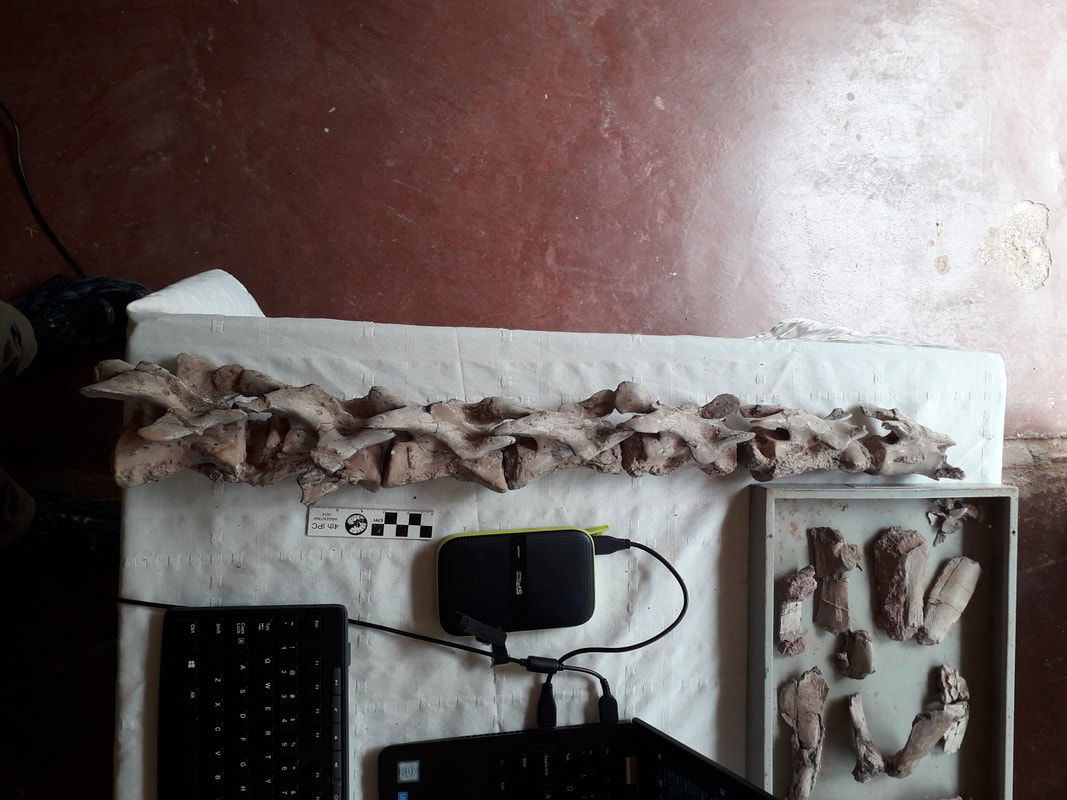|
While visiting Plaza Huincul a few weeks ago, I was chatting with Rodolfo Coria about my plans for the rest of my trip. When I mentioned that I was going to visit Lago Barreales to see ornithopods, he told me that one of the specimens — a dinosaur called Macrogryphosaurus — was so beautifully preserved that it was as if it had died yesterday. Intrigued, I could not wait to see it. I re-read the Macrogryphosaurus paper later that week, and found myself a little underwhelmed. The bones looked OK in the figures, but not earth-shatteringly awesome. I decided to reserve judgment until I saw the specimen for myself. Once my time in Plaza Huincul was up, I caught a taxi to Cipolletti. I had three days in the hotel to consolidate the work I had done to that point before Jorge Calvo, the palaeontologist at Lago Barreales, picked me up to take me there. Although the initial plan was to spend four days working there, I ended up doing so for seven days straight! I spent the first two on Megaraptor (as mentioned here) before moving on to Macrogryphosaurus, which I had finished with before the end of day four. Having now studied it firsthand, I could not agree more with Rodolfo — Macrogryphosaurus is amazing. The preservation of most of the bones is immaculate, despite the fact that many are broken and that the vertebrae between the hips have been slightly crushed. More amazingly, so much of the animal is preserved: most of the neck, the entire thorax, the whole pelvis and a significant portion of the tail. The ribs and several dorsal vertebrae have been left together, in the position in which they were fossilised, which made photographing them difficult. Nevertheless, I was quite happy with the results, despite the fact that I was not able to take any automatically stacked images, thanks to my computer/camera lens packing it in in Plaza Huincul! Backing up for a moment, I realise that I have not introduced Lago Barreales properly. The Museum known as Proyecto Dino sits on the north shore of Lago Barreales (Barreales Lake), about 88 km northwest of Neuquén. This lake, and its near neighbour Lago Marí Menuco, are artificial: once dry basins, a deliberate partial deviation of the Neuquén River has caused them to fill with water. As a result of numerous fossil discoveries in the area — particularly at a site now known as Futalognko — a research facility was built that now operates as a museum, an educational centre and a tourist attraction. In May 1999 — before the Proyecto Dino museum was built — the Universidad Nacional del Comahue ran a geological field trip to sites near Lago Marí Menuco. While there, the team was informed by a boy named Rafael Moyano of a dinosaur discovery. The specimen was collected and prepared, and in 2007 Jorge Calvo, Juan Porfiri and Fernando Novas described it as the new ornithopod species Macrogryphosaurus gondwanicus — the “Gondwanan big enigmatic lizard”. The specimen was found to be remarkable in several ways: bony plates were present on the rib cage that were only otherwise known from a few other ornithopods; the sternum had projections in three different directions; and the neck was quite long by ornithopod standards, comprising ten elongate vertebrae. As a result of studying Macrogryphosaurus, I now have an appreciation for just how weird it is compared to most other non-iguanodontian ornithopods. At around 5–6 metres long, Macrogryphosaurus was quite small as far as dinosaurs go, but relatively large for a non-iguanodontian ornithopod. Indeed, its only rival in that regard is another Argentinean ornithopod — which I’ll be studying in ten days’ time! Lastly, the neck of Macrogryphosaurus made me think of an east African antelope called a gerenuk. Gerenuks have much longer necks than other antelope, allowing them to browse at a higher level than would be possible for most other species. They also routinely rear up on to their hind legs so that they can reach even higher into the trees — up to two metres. Perhaps Macrogryphosaurus was putting its relatively long neck to a similar use? References Calvo, J.O., Porfiri, J.D. & Novas, F.E., 2007. Discovery of a new ornithopod dinosaur from the Portezuelo Formation (Upper Cretaceous), Neuquén, Patagonia, Argentina. Arquivos do Museu Nacional, Rio de Janeiro 65, 471–483.
1 Comment
Solicitar un préstamo ahora
1/23/2024 10:43:48 am
Buenos días señor / señora,
Reply
Leave a Reply. |
Stephen PoropatChurchill Fellow (2017) on a palaeo-tour of Argentina! Archives
December 2018
Categories |


 RSS Feed
RSS Feed
